Everything You Need to Know About Pet Macaws
From their curious intelligence and ability to talk, to the beautiful plumage and potential cuddliness, it's no surprise that parrot lovers consider getting a macaw for a pet.
"They are all unique. Every macaw I have met has been different, just like any person you meet," Victoria Caroglanian, vice president of The Wilson Parrot Foundation in Damascus, Maryland, shared.
The non-profit assists with pet parrot rescues, rehabilitation, and rehoming to qualified homes. They work with many types of macaws, as well as other parrot species, including conures, Sengals, African greys, Amazons, eclectus, and more.
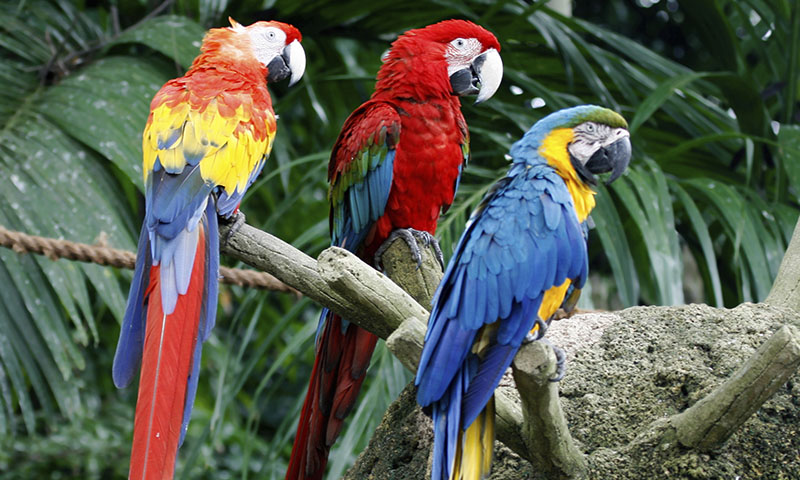
A Scarlett macaw, Green-winged macaw, and a Blue-and-gold macaw
What Colors Are Macaws?
The 17 species of macaws, which originate from Central and South America, come in a rainbow of color combinations.
Caroglanian says they currently care for seven types of companion pet macaws at the rescue. This gives you a good snapshot of the most common types and colors of macaws kept as pets. These include:
-
Blue-and-gold: As the name says, blue and gold!
-
Military: Green with a red unibrow
-
Buffons: Green with a red unibrow (and smaller than the Military)
-
Scarlett: Bright red body with orange, yellow, blue, and green on the wings
-
Green-winged: A deep red body with blue and green on the wings and tail
-
Hyacinth: Deep blue body with yellow outlines around the eyes and beak
-
Harlequin: A mix between the Blue-and-gold and the Green-winged
Learn more about macaws, and specifically the Hyacinth, Scarlett, Green-winged, Blue-and-gold, and Yellow-collared in 5 Types of Macaw.
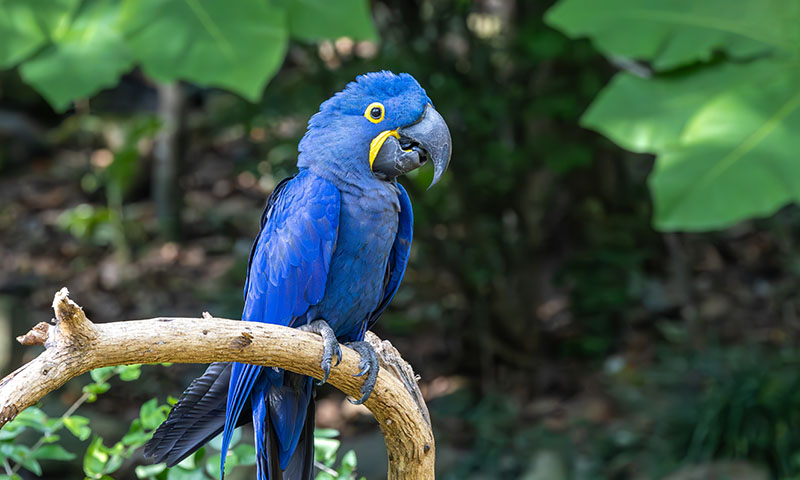
Hyacinth macaw perched on a branch.
How Big Do Macaws Get?
Macaws win the award for the largest parrot in the parrot (psittacines) family. It can take one to three years for a macaw to reach her full adult size.
Macaws are often categorized as either mini or large. A few examples include:
Mini macaws:
-
Hahns: Grows to approximately 30 cm in length
-
Military: Grows to approximately 70-80 cm in length
Large macaws:
-
Scarlett: Grows to approximately 81-96 cm in length
-
Buffons: Grows to approximately 85-90 cm in length
-
Hyacinth: Grows to approximately 100 cm in length
Macaws require both an aviary for a home as well as "plenty of time out of the aviary throughout the day," Caroglanian explained.
Mini macaws require an aviary of at least 3' wide by 3' tall and 4' long. Large macaws need a minimum of 4' wide by 5' tall and 5' long. The bars should measure no wider than 1 to 1.5" apart (with the wider gap suiting larger birds).
Fill the home with a variety of perches (twisted wood, braided hemp, cotton rope, etc.) to stretch their feet, bowls for food and water, and lots of toys. (More on those soon!)
For time outside the aviary, you can set up a perching station (sometimes called a bird playground or play gym) in your living room, home office, or wherever you want your bird buddy to hang out. For safety, turn off ceiling fans and close all windows and doors to prevent Houdini moments. Be mindful of other pets in the home and whether or not they get along with your macaw. Perhaps bird time coincides with when your dog enjoys the backyard. Finally, offer food and water in all play areas.
For aviary, playtime, and playground inspiration, browse YouTube to see other macaw parents' setups for their feathered friends. Some even use pet harnesses to take their parrots to parks.
Take a peek at these to get started:
Note: Pet birds can have their flight feathers painlessly trimmed to limit flying. Ask your avian veterinarian about this option if you plan to take your pet outdoors without her being secured in an aviary.
Whether your bird spends time indoors or outdoors, keep her away from potential toxins such as scented candles, cooking fumes from tools with non-stick surfaces (air fryers, pans, etc.), aerosol sprays (hair styling products, cooking oils, etc.), cigarette smoke, and more. View this extensive list that includes toxic wood types, plants, heavy metals, and airborne chemicals.
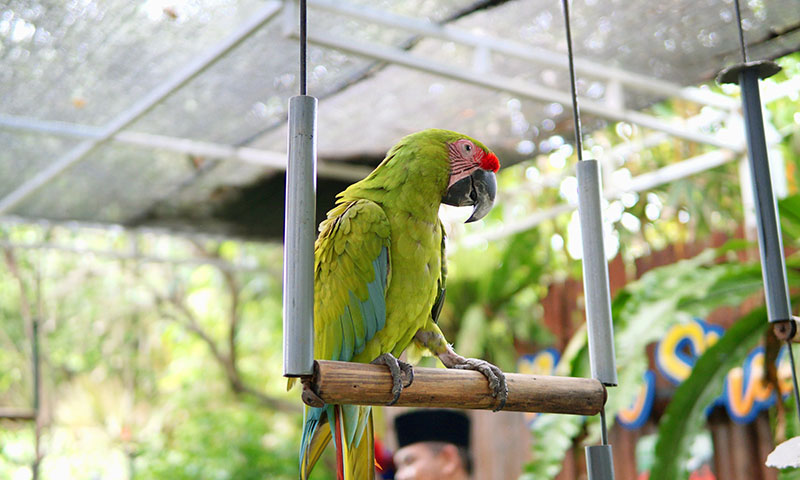
Military macaw perched on a swing.
Do Macaws Like Toys?
Yes, most macaws enjoy toys. However, just like humans, each bird has a unique personality, including likes and dislikes.
Macaws specifically enjoy toys that encourage foraging, or finding food. This might look like tucking a piece of raw fruit inside a hard wooden ball for her to dig out with her bill. All macaws have large hooked bills that curve downward. These help them to easily crack whole nuts, shred paper, and pry open toys.
Since macaws have abundant curiosity, they love to attempt puzzles and interlocking toys that offer a nut (or other treats) when the puzzle gets solved.
Take note, macaws destructively chew! They can gnaw through wood easily, so toys will require replacing often. You can give them untreated lumber cut into chunks for playtime, a swing to glide on, and a rope filled with knots (no loops that could catch their feet or head) for climbing.
Try rotating out toys every few days to keep your bird from experiencing boredom with the same activities each day. Of course, toys don't replace time with you! Connect with your pet daily.
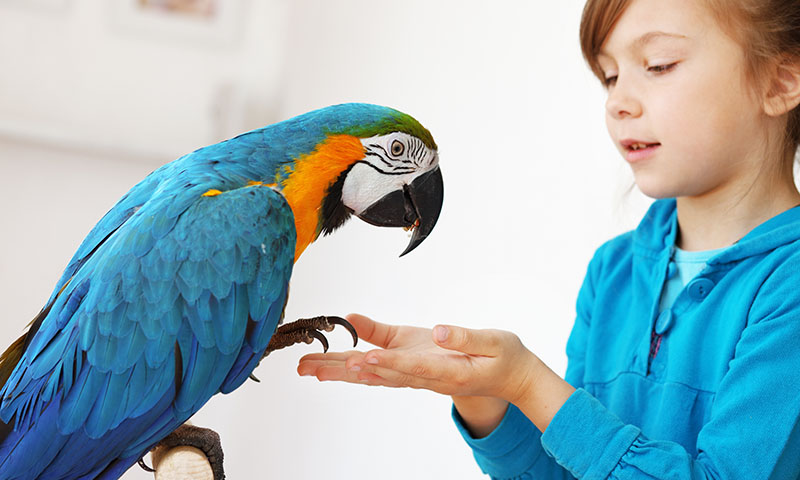
Girl playing with Blue-and-gold macaw.
How Can I Bond with My Macaw?
Macaws love to socialize with humans and other macaw friends. However, this can take time and patience, according to Caroglanian.
When you initially bring your pet home, she may become suspicious and try to bite. Avoid sudden movements, as well as loud noises, and let the bird familiarize herself with her new space.
Then create a daily routine that allows you and your bird to bond over familiar tasks, including refilling fresh water, offering new food, and tidying up the aviary.
"The best way to bond is to spend time with the macaw. Sit with it, even if it wants to be caged, in the same room with it. Talking with it, singing with it. They love that," she explained.
And of course, macaws enjoy tasty treats.
"Some macaws are very food motivated. Sometimes, if you're eating in the same room, the macaw may wander over and try to snag a bite of your pizza. It has happened one too many times with me," Caroglanian shared.
Good treats to offer your pet during bonding time include whole walnuts or almonds in the shell for the bird to crack open. As she works on the nut, talk with her in a calm voice to help build a trusting connection.
What Sounds Do Macaws Make?
Macaws can vocalize in a few ways, with talking and screaming happening most often. And they do it loudly. Macaws, like toddlers, lack volume control!
"They are incredibly loud if they want to be. Some species can get up to 106 decibels," Caroglanian explained. For comparison, that's a little louder than a motorcycle or a jackhammer! Wild bird calls measure around 44 decibels. She says macaws call out at the tops of their lungs when a new person walks by the aviaries at the rescue, and when volunteers leave the room.
Some macaws learn to mimic human language and even use the words in context to show off their intelligence.
"One of our macaws loves to play. He will purposely drop a nut or a toy and then say, 'Uh oh.' He knows that he almost always gets a reaction, so it encourages his behavior," she added. "Some of the macaws say 'Hi,' 'Hello,' 'What doing?,' 'Peek-a-boo,' 'Night night,' 'Stop it!,' etc."
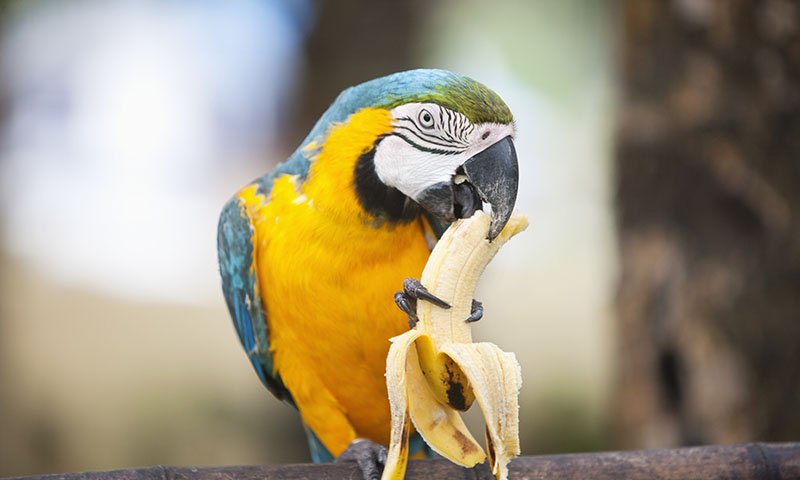
Blue-and-gold macaw eating a banana.
What Do I Feed My Macaw?
Like all parrots, macaws require a balanced diet. Each day, your parrot should have access to fresh, clean water and a meal plan consisting of 75% bird food pellets; 15% fresh produce, grains, and legumes; and 10% treats such as seeds and nuts. Macaws love to crack open whole almonds, walnuts, palm nuts, and macadamia nuts.
As you shop for bird food for your macaw, consider one of these options:
-
Kaytee Fiesta Macaw Food: A pet bird nutritionist developed this mix of ingredients, shapes, and textures to appeal to your pet macaw. They'll discover tasty vegetables; pumpkin seeds; fruits, like apples, coconut, and blueberries; grains; and peanuts.
-
Kaytee Fiesta Big Bites Macaw Food: Does your parrot love chunky food? This mix features large pieces to help engage your pet at feeding time, in turn helping to reduce boredom. Your macaw will work to open shelled pistachios and almonds, crunch on dried zucchini and carrots, and so much more!
-
Forti-Diet Pro Health Nourish & Protect: This mix features fruits, seeds, nuts, veggies, and more. Macaws love to explore the dried red peppers, green split peas, and whole peanuts. The probiotics, prebiotics, and antioxidants in this blend support skin, feather, and immune health.
-
Kaytee NutriSoft Macaw & Cockatoo Food: Does your macaw have a preference for soft, fresh fruits? She might love the unique, soft texture of this food since it mimics the produce your bird would find in the wild. This pellet diet features nutrients to support digestive, heart, brain, skin, and feather health.
When it's time to fill your parrot's fresh produce bowl, consider these options. At the rescue, the macaws dine on the following fresh, uncooked, chopped fruits and veggies:
-
Apples
-
Beans (different varieties)
-
Bell peppers (no need to remove the seeds)
-
Broccoli
-
Carrots
-
Cauliflower
-
Chickpeas
-
Corn
-
Cucumber
-
Grapes
-
Green beans
-
Jalapeno peppers (no need to remove the seeds)
-
Melons
-
Oranges
-
Peaches
-
Pears
-
Pomegranate
-
Sugar snap peas
-
Sweet potato
"Lastly, we give our parrots cooked pasta! They love their pasta," Caroglanian added. This fits into that 10% treat category. Keep the pasta plain. Skip the butter, oils, seasonings, and sauces to keep it bird-friendly.
Although macaws can have a huge variety of produce we enjoy, some foods and beverages may be toxic. These include potato skins, avocado, chocolate, and caffeinated items such as soda, coffee, and tea.
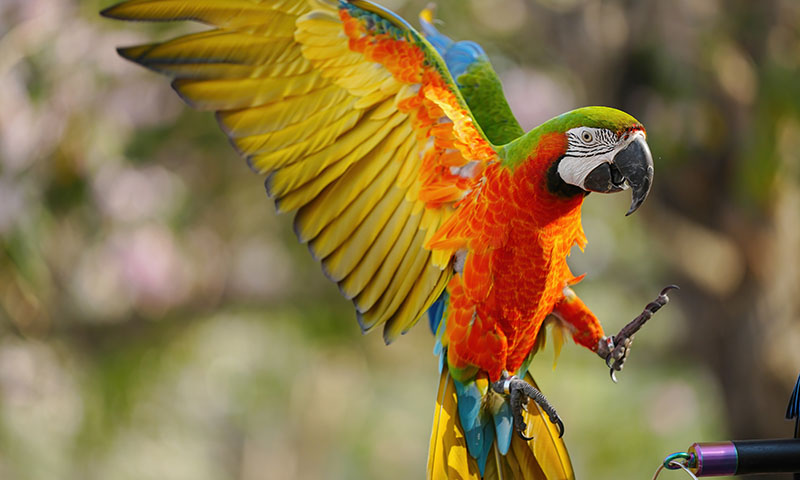
Harlequin macaw in flight.
Macaws Are Not Starter Birds
Thanks to their large size, abundant intelligence, and ample care needs, macaws generally don't fit well into first-time bird parent homes.
"I 150% recommend volunteering at a rescue and gaining knowledge before adopting one," Caroglanian expressed. "Too many times, I have had people come into the rescue claiming they want a pet macaw and adopt an Amazon instead!" (Bird lovers find the smaller size of an Amazon parrot easier to manage.)
You can also chat with your local avian veterinarian to better understand the needs of pet macaws. Or visit a local zoo and ask the caretakers about their macaw care routines.
"Macaws are often one-person animals. They bond to one person and that is it," Caroglanian added. "That is why it is important to realize the commitment and responsibility that they are."
Do you have the time, patience, and finances to create a large aviary and playground setup — as well as offering daily socializing with a macaw? These beautiful parrots can live up to 60 years, which means it's smart to have a younger family member or friend lined up to care for your pet after your passing.
"They are a lifelong commitment! Often, they outlive their owners," she added. "They are so much more than a cool-looking pet. Make sure you have the time to devote to a macaw before getting one. They are a huge, huge, huge responsibility. I cannot stress that enough. However, the amount of love they hold for their owners is beautiful. It's a bond that is indescribable."
Macaws Make Great Parrot Pets
If you're ready to add a large, lovable parrot to your family, have ample time to spend with your bird each day, and plenty of space for the pet to play, a macaw might make your world a much brighter place — literally and figuratively!
Learn more in Choosing the Right Pet Bird and What is the best diet for pet parrots?
